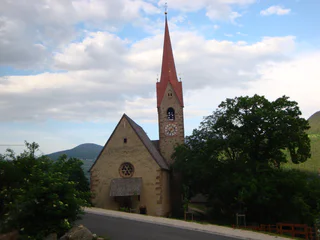
1/2
The church of St. Ingenuin and Albuin in Saubach
Ponte Gardena/Waidbruck, Barbian/Barbiano, Brixen/Bressanone and environs

1/2
Ponte Gardena/Waidbruck, Barbian/Barbiano, Brixen/Bressanone and environs

1/2
Valdurna/Durnholz, Klausen/Chiusa, Brixen/Bressanone and environs

1/3
Lazfons/Latzfons, Klausen/Chiusa, Brixen/Bressanone and environs

1/2
Villandro/Villanders, Villanders/Villandro, Brixen/Bressanone and environs

1/3
Lazfons/Latzfons, Klausen/Chiusa, Brixen/Bressanone and environs

Lazfons/Latzfons, Klausen/Chiusa, Brixen/Bressanone and environs

1/3
Giovignano/Tschiffnon, Feldthurns/Velturno, Brixen/Bressanone and environs

1/3
Giovignano/Tschiffnon, Feldthurns/Velturno, Brixen/Bressanone and environs

1/2
Colma/Kollmann, Barbian/Barbiano, Brixen/Bressanone and environs

1/3
Colma/Kollmann, Barbian/Barbiano, Brixen/Bressanone and environs

Lazfons/Latzfons, Villanders/Villandro, Brixen/Bressanone and environs

Lazfons/Latzfons, Klausen/Chiusa, Brixen/Bressanone and environs

1/5
Colma/Kollmann, Barbian/Barbiano, Brixen/Bressanone and environs

1/6
Giovignano/Tschiffnon, Feldthurns/Velturno, Brixen/Bressanone and environs

1/3
Lazfons/Latzfons, Klausen/Chiusa, Brixen/Bressanone and environs

Lazfons/Latzfons, Klausen/Chiusa, Brixen/Bressanone and environs

Caerna/Garn, Villanders/Villandro, Brixen/Bressanone and environs

1/6
Colma/Kollmann, Barbian/Barbiano, Brixen/Bressanone and environs

1/2
S.Martino/Reinswald, Villanders/Villandro, Brixen/Bressanone and environs

1/8
Untrum/Untrum, Feldthurns/Velturno, Brixen/Bressanone and environs

Untrum/Untrum, Klausen/Chiusa, Brixen/Bressanone and environs

1/3
Lazfons/Latzfons, Villanders/Villandro, Brixen/Bressanone and environs

1/5
Villandro/Villanders, Villanders/Villandro, Brixen/Bressanone and environs

Ponte Gardena/Waidbruck, Barbian/Barbiano, Brixen/Bressanone and environs

1/3
Giovignano/Tschiffnon, Feldthurns/Velturno, Brixen/Bressanone and environs

Ponte Gardena/Waidbruck, Barbian/Barbiano, Brixen/Bressanone and environs

S.Martino/Reinswald, Sarntal/Sarentino, Brixen/Bressanone and environs

Ponte Gardena/Waidbruck, Waidbruck/Ponte Gardena, Brixen/Bressanone and environs

Untrum/Untrum, Klausen/Chiusa, Brixen/Bressanone and environs

1/2
Villandro/Villanders, Villanders/Villandro, Brixen/Bressanone and environs